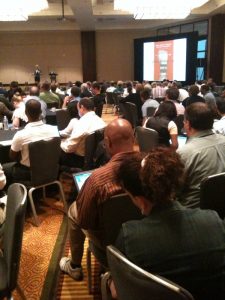This article is more than 5 years old.
This week I’m attending the 2010 Sakai conference at the Denver Technology Center, about 15 miles from downtown Denver. As the migration from the Blackboard Learning Management System (LMS) to the open-source system, Sakai, approaches (see Information Systems article from March) I feel fortunate to be able to attend this conference (as one of a group of five from Wake Forest) and learn more about this new open-source LMS. This conference feels very different from the national Blackboard conferences I’ve attended. The open-source nature of this initiative creates a collaborative environment among the various schools participating where the feeling is more like a community rather than conference of product-users.
Tuesday morning, the keynote speaker was Anya Kamenetz, author, of “DIY U: Edupunks, Edupreneurs, and the coming Transformation of Higher Education.” She was also the author of “Generation Debt.” She talked about the barriers to higher education (not only financial barriers but also barriers created by higher education delivering a product that has remained unchanged for many years.) She discussed issues of cost, quality and access and the value of collaborative learning, not just for students but for everyone. I’ve included a link to an article that explains her work better than I can.
Next I attended the session on “Teaching/Course Portfolios” led Dr. Teggin Summers, the Assistant Director for Virginia Tech’s ePortfolio Initiatives, and Marc Zaldivar the Director of the ePortfolio Initiatives. This discussion focused on the value of course portfolios not for students but for teachers, assisting them in creating courses around the “Quality Matters” standards.
Two sessions ran back to back under the topic of “deploying issues.” The first program, “Reflections on two years implementing Sakai” was led by Patrick Lynch, the eLearning Coordinator at the University of Hull. Hull replaced two systems, Blackboard and MERLIN, a homegrown system, with Sakai. Lynch focused on the value of surveying users rather than depending on anecdotal feedback, and he included some “uncomfortable truths” (his words, not mine) about their experiences. Along that same line, the next program, “Who Moved My Course?: A Faculty Perspective on LMS Transitions,” led by Roger Henry, a Learning Technologies Consultant with the Teaching and Learning Technologies Centers at Indiana University, focused on the successes and lessons learned during a rapid migration of their Executive Certificate in the Business of Life Sciences program from Angel to Oncourse (Sakai). Henry used an interesting technique to describe the issues he faced. He created archetypal instructors to show the various opinions, attitudes and issues that arose during this rapid migration.
The session “SMS, Questions & Answers & Course Evaluation in Sakai” by Stephen Marquard of University of Cape Town was very relevant to ZSR. Marquard is the Learning Technologies Coordinator at the University of Cape Town, where he is responsible for the University’s popular Sakai deployment known as Vula. In addition to interesting uses of SMS he focused on the contribution tool for course evaluations in Sakai. This tool may be very useful as we migrate Lib100 evaluations from Blackboard to Sakai. Here is a link to information about the tool.
I also attended a session called “Open Syllabus in Sakai 2.6: Up and Running!” by Jacques Raynauld, a faculty member at HEC Montreal and is the director of MATI Montreal (www.matimtl.ca), a University of Montreal campus research lab on technology, teaching and learning. He presented to the Open Syllabus contribution tool that helps instructors organize their course’s material. This tool makes content in Sakai very visually pleasing and gives the instructor an engaging interface for creating a syllabus while also giving the student a central place for accessing that same content.
To learn more about the conference and the session, visit the 2010 Sakai Conference website! I’ll post an entry about Day Two tomorrow!


2 Comments on ‘2010 Sakai Conference, Denver – Day One’
Glad you could be there to cover the conference for us, Giz!
I can’t wait for the PDC event where you show us all the stuff your learning, Giz.